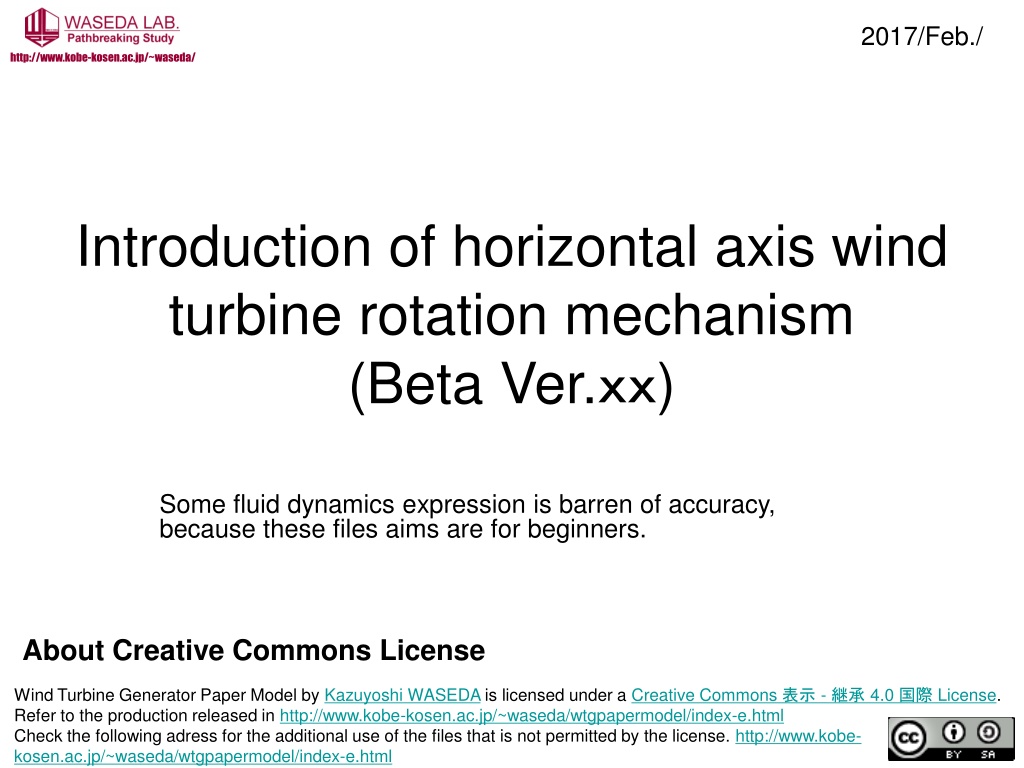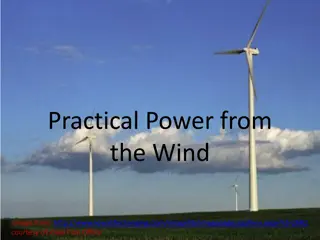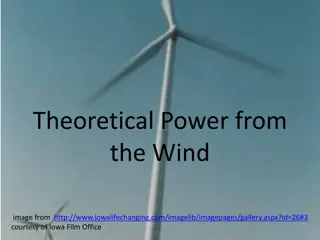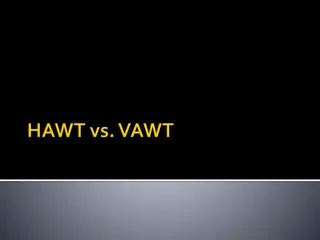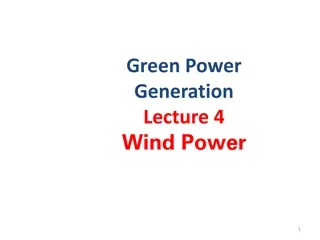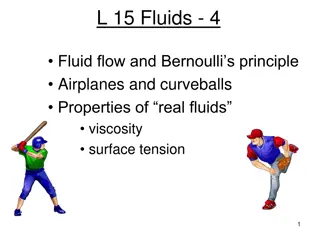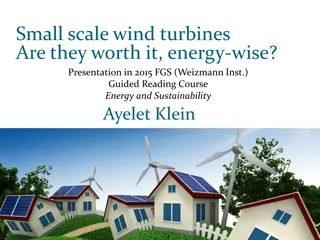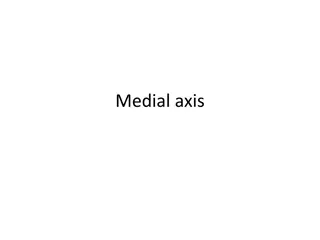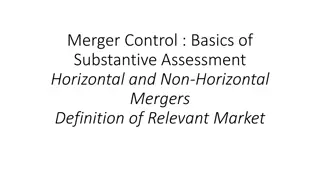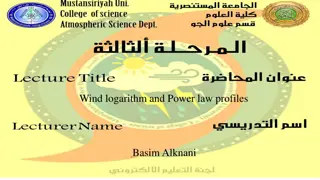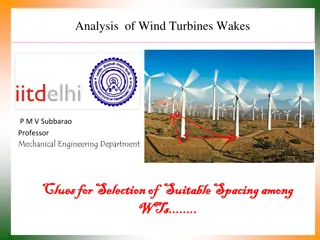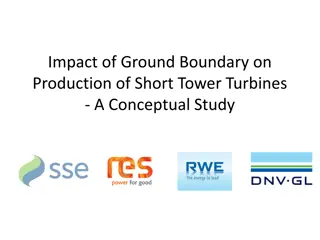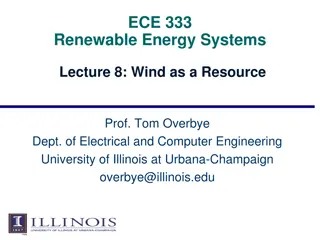Understanding Horizontal Axis Wind Turbines and Fluid Dynamics
Explore the world of horizontal axis wind turbines through an introduction to the rotation mechanism and foundational concepts of fluid dynamics and airfoil theory. Delve into Reynolds Number, lift and drag forces, and the components of wind turbines. Gain insights into the misconceptions surrounding lift generation and learn how shape optimization impacts turbine efficiency.
Download Presentation

Please find below an Image/Link to download the presentation.
The content on the website is provided AS IS for your information and personal use only. It may not be sold, licensed, or shared on other websites without obtaining consent from the author. Download presentation by click this link. If you encounter any issues during the download, it is possible that the publisher has removed the file from their server.
E N D
Presentation Transcript
2017/Feb./ http://www.kobe-kosen.ac.jp/~waseda/ Introduction of horizontal axis wind turbine rotation mechanism (Beta Ver. ) Some fluid dynamics expression is barren of accuracy, because these files aims are for beginners. About Creative Commons License Wind Turbine Generator Paper Model by Kazuyoshi WASEDA is licensed under a Creative Commons - 4.0 License. Refer to the production released in http://www.kobe-kosen.ac.jp/~waseda/wtgpapermodel/index-e.html Check the following adress for the additional use of the files that is not permitted by the license. http://www.kobe- kosen.ac.jp/~waseda/wtgpapermodel/index-e.html
Contents Variety of horizontal axis wind turbine Foundation of Fluid dynamics and Airfoil element theory Horizontal axis wind turbine rotation mechanism What is Reynolds Number ?
Variety of horizontal axis wind turbine
Up wind type - Down wind type
Up wind type Down wind type Wind Wind Rotor blade located at front side of the tower Rotor blade located at back side of the tower
Names of parts Airfoil Rotor Blade Nacelle Hub (root of the blade) Spiner Tower Rotor Blade Nacelle Spinner Airfoil Hub Tower
Horizontal axis wind turbine rotation mechanism
Before the wind turbine rotation mechanism,,, Foundation of Fluid dynamics and Airfoil element theory See Wikipedia: Misunderstandings about the generation of lift http://en.wikipedia.org/wiki/Bernoulli%27s_principle#Misunderstandings_about_the_generation_of_lift Lift (force) http://en.wikipedia.org/wiki/Lift_%28force%29 More accurate information of fluid dynamics and the blade element theory NASA:Incorrect Lift Theory http://www.grc.nasa.gov/WWW/k-12/airplane/wrong1.html NASA:Incorrect Lift Theory #2 http://www.grc.nasa.gov/WWW/k-12/airplane/wrong2.html
Lift and Drag Lift: Normal force caused by flow Drag: Parallel force caused by flow L Lift Airfoil Flow D Drag Airfoil: The shape which maximize the lift and minimize the drag
Its relatively same state! Put an airfoil into the air flow = Move forward an airfoil in the (no flow) air L Lift airfoil Flow D Drag Relatively same state L Lift airfoil No Flow D Drag Move forward [airfoil]
Law of continuity (Flow rate) Q[m3/s]=A[m2]V[m/s] constant Q: flow rate[m3/s] A Cross section of flow [m2] Pipe V Flow velocity [m/s] Broad Small wide Cross section narrow A2 A1 Pipe V2 Slow Flow velocity Fast V1 Flow Rate Q[m3/s]=A1V1=A2V2=Constant
Whats happened at around the airfoil ? =upper surface flow velocity is higher than lower surface Narrow cross section upper surface flow velocity is higher than lower surface upper surface Flow lower surface
Bernoulli's principle p = + 1 2 . V const V Flow velocity [m/s] p Pressure[Pa] Density of the fluid [kg/m3] 2 Dynamic Pressure + Piezometric head = const. Flow See Wikipedia: Misunderstandings about the generation of lift http://en.wikipedia.org/wiki/Bernoulli%27s_principle#Misunderstandings_about_the_generation_of_lift Lift (force) http://en.wikipedia.org/wiki/Lift_%28force%29
Bernoulli's principle 1 2 2 V + = p1>p2 1 p p 2 + = . 1 2 V const 1 2 2 V1,V2 Flow velocity [m/s] p1,p2 Pressure[Pa] Density of the fluid [kg/m3] Lift force p2 V2 p1 V1 Flow p1 V1 p1 V1 Airfoil upper surface shape >>> accelerate flow velocity >>> Low pressure >> Lift force
Some fluid dynamics expression is barren of accuracy,,, In any case, an airfoil is the shape that regarded low drag force as high lift force
It is ideal to Keep the AoA which shows Largest Lift force-Drag force rate What is Angle of Attack (AoA: ) Large AoA gives not only high lift force(L) but also high drag force(D) Larger AoA is trigger of the stall (separation flow) It is ideal to Keep the AoA which shows Largest Lift-Drag rate (L/D or CL/CD) CL: Lift Coefficient CD: Drag Coefficient
It is ideal to Keep the AoA which shows Largest Lift force-Drag force rate What is Angle of Attack (AoA: ) Large AoA gives not only high lift force(L) but also high drag force(D) Larger AoA is trigger of the stall (separation flow) It is ideal to Keep the AoA which shows Largest Lift-Drag rate (L/D or CL/CD) CL: Lift Coefficient CD: Drag Coefficient
What is Angle of Attack (AoA: ) The angle of attack is the angle between the chord line of an airfoil and the oncoming air. AoA: Lift force Flow Drag force
It is ideal to Keep the AoA which shows Largest Lift force-Drag force rate What is Angle of Attack (AoA: ) Large AoA gives not only high lift force(L) but also high drag force(D) Larger AoA is trigger of the stall (separation flow) It is ideal to Keep the AoA which shows Largest Lift-Drag rate (L/D or CL/CD) CL: Lift Coefficient CD: Drag Coefficient
Large AoA gives not only high lift force(L) but also high drag force(D) Large AoA Large lift force Flow Large drag force too
It is ideal to Keep the AoA which shows Largest Lift force-Drag force rate What is Angle of Attack (AoA: ) Large AoA gives not only high lift force(L) but also high drag force(D) Larger AoA is trigger of the stall (separation flow) It is ideal to Keep the AoA which shows Largest Lift-Drag rate (L/D or CL/CD) CL: Lift Coefficient CD: Drag Coefficient
Larger AoA is trigger of the stall (separation flow ) Separation flow (airfoil performance is as same as simple flat panel) Significantly decreases the lift force Larger AoA Stall Flow Significantly increases the drag force
It is ideal to Keep the AoA which shows Largest Lift-Drag rate (L/D or CL/CD) [Carry out the performance test of airfoil in all AoA range]
Large AoA gives not only high lift force(L) but also high drag force(D) Lift CL: Lift Coefficient CD: Drag Coefficient Stall Drag 0o AoA:
Glide ratio [Lift-Drag rate] L/D[CL/CD] L/D maximum Stall AoA which shows Largest Lift-Drag rate 0o AoA:
Horizontal axis wind turbine rotation mechanism
Horizontal axis wind turbine rotation mechanism v=r [m/s] v=r [m/s] Blade plane of rotation Wind W[m/s] Apparent wind V[m/s] Using Microsoft Power Point animation function
Horizontal axis wind turbine rotation mechanism Lift Drag v=r [m/s] Blade plane of rotation Wind W[m/s] Apparent wind V[m/s] Rotation direction force by lift Rotation direction force by drag(opposite direction) The difference is Actual Rotation direction force Using Microsoft Power Point animation function
Altogether "Large Lift-Drag rate" means "Wind turbine rotate"
Why the wind turbine blade is twisted?
Why the wind turbine blade is twisted? There is velocity difference between at the root and the tip of the blade 2 r = = v r 2 = r2 T T angular velocity [rad/s] r1 T:time < 2 2 r r = = = = 1 v r 2 v r 1 1 2 2 T T v1 The tip of the blade is higher in rotational speed than the root v2
When it suppose to be the central position of the blade v=r [m/s] Blade plane of rotation Wind W[m/s] Apparent wind V[m/s]
When it suppose to be the tip of the blade v=r [m/s] Blade plane of rotation Wind W[m/s] Apparent wind V[m/s]
When it suppose to be the root of the blade v=r [m/s] Blade plane of rotation Wind W[m/s] Apparent wind V[m/s]
v=r[m/s] Blade plane of rotation Wind W[m/s] Apparent wind V[m/s]
v=r[m/s] Blade plane of rotation Wind W[m/s] Apparent wind V[m/s]
v=r[m/s] Blade plane of rotation Wind W[m/s] Apparent wind V[m/s]
v=r[m/s] Blade plane of rotation Wind W[m/s] Apparent wind V[m/s]
v=r[m/s] Blade plane of rotation Wind W[m/s] Apparent wind V[m/s]
v=r[m/s] Blade plane of rotation Wind W[m/s] Apparent wind V[m/s]
v=r[m/s] Blade plane of rotation Wind W[m/s] Apparent wind V[m/s]
If Blade is not twisted(straight), AoA is not optimized -> Optimized the AoA( ) for each blade position =twist the blade Blade plane of rotation Wind W[m/s] Apparent wind V[m/s] at root Apparent wind V[m/s] at center position of the blade of the blade Apparent wind V[m/s] at tip of the blade
Optimized the AoA() for each blade position v=r [m/s] Blade plane of rotation Wind W[m/s] Apparent wind V[m/s]
Optimized the AoA() for each blade position v=r [m/s] Blade plane of rotation Wind W[m/s] Apparent wind V[m/s]
Optimized the AoA() for each blade position v=r [m/s] Blade plane of rotation Wind W[m/s] Apparent wind V[m/s]
Optimized the AoA() for each blade position v=r [m/s] Blade plane of rotation Wind W[m/s] Apparent wind V[m/s]
Optimized the AoA() for each blade position v=r [m/s] Blade plane of rotation Wind W[m/s] Apparent wind V[m/s]
Optimized the AoA() for each blade position v=r [m/s] Blade plane of rotation Wind W[m/s] Apparent wind V[m/s]
Optimized the AoA() for each blade position v=r [m/s] Blade plane of rotation Wind W[m/s] Apparent wind V[m/s]
